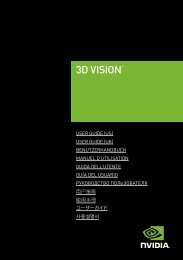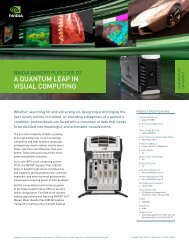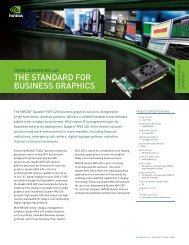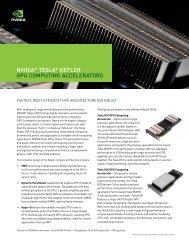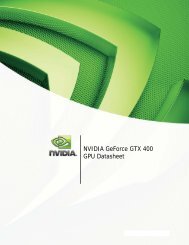Tegra 4 Whitepaper - Nvidia
Tegra 4 Whitepaper - Nvidia
Tegra 4 Whitepaper - Nvidia
- No tags were found...
You also want an ePaper? Increase the reach of your titles
YUMPU automatically turns print PDFs into web optimized ePapers that Google loves.
P a g e | 8Object cache, split 16KB per VPE, allows vertex reuse and reduces off-chip memory accesses.Architectural improvements have resulted in a performance increase of up to 1.5x over NVIDIA ®<strong>Tegra</strong> ® 3 processor per vertex pipe when running at the same clock. The vertex shader coresuse FP32 precision for their computation to ensure geometric accuracy.As described in the Logical Pipeline section, primitives are assembled from the vertices, andany primitives that aren’t visible or back-facing are culled, or if they extend beyond the viewfrustum they are clipped. Edge and plane equations are calculated on the primitives inpreparation for rasterizing.Raster Engine and Early-ZThe Raster Engine generates pixel fragments from the primitives and can provide eight pixelfragments per clock to the Pixel Shader pipes, similar to the <strong>Tegra</strong> 3 processor. Both the <strong>Tegra</strong>4 processor and the <strong>Tegra</strong> 4i processor now support 2x and 4x Multisample Antialiasing(MSAA), 24-bit Z, and 8-bit Stencil processing. The Raster Unit generates pixel fragments(samples when MSAA is enabled) with associated 24-bit Z and 8-bit stencil values.The Early-Z unit works in concert with the Raster Unit and is an optimized version of theimplementation used in high end desktop GeForce GPUs. The Early-Z operation tests all thepixels or samples for Z-depth, and only passes on pixels or samples that are visible. Byperforming an Early-Z test and discarding hidden pixels, much wasted work fetching Z, color,and texture data for hidden pixels is avoided, in addition to avoiding much unnecessary pixelcomputation in the Pixel Shader pipes. Early-Z is able to detect and discard hidden pixels at arate of eight pixels/clock (8ppc).Early-Z processing delivers improved performance and power savings by reducing memorytraffic between the GPU and off-chip memory. In rare situations, the programmer may requirecertain pixels to be hidden until pixel processing is complete. For these cases, a late-stagedepth test occurs within the pixel shader and blend units.VLIW Pixel Fragment Shader PipelinesEach of the four Pixel Fragment Shader pipes in the <strong>Tegra</strong> 4 processor’s GPU includes threeALUs, and each ALU contains four MAD units, for a total of 48 pixel shader cores (4 x 3 x 4). Asingle MFU (Multi-Function Unit) is included per ALU for a total of 12 MFU units. The MFU unitsprocess transcendental math (logs, exponents, trigonometric, functions), reciprocals, squareroots, and MOV operations.The Fragment Shader pipelines implement a VLIW architecture, where a mix of differentinstructions can be issued to the four MAD units and MFU unit in each ALU. Examples ofdifferent VLIW instruction mixes are as follows:4x MAD2x DP2A + MFU1x DP3A + 1xMAD + MFU1x DP2A + 2xMAD + MFUNVIDIA <strong>Tegra</strong> 4 GPU Architecture February 2013



